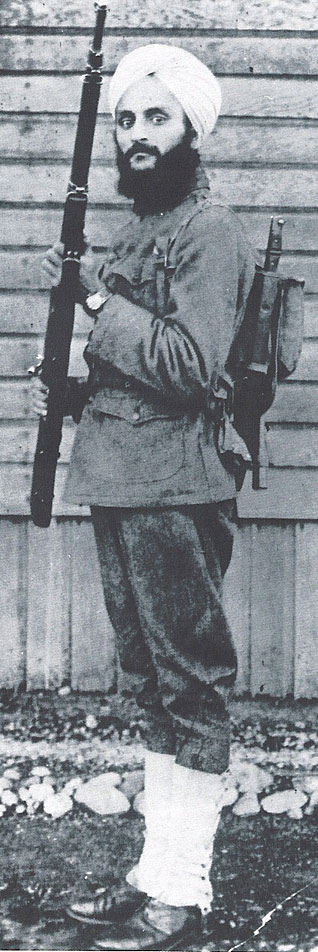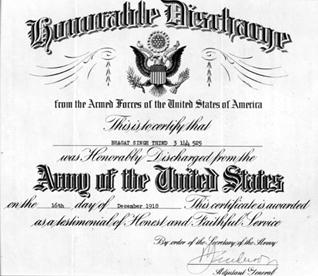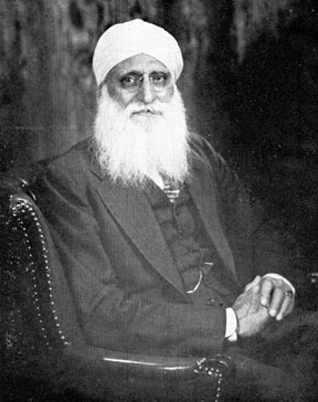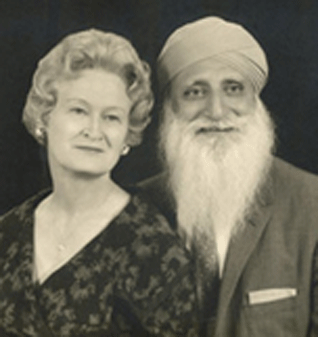History
Harvard Law School Re-enacts Landmark Case: U.S. vs. Bhagat Singh Thind
by NAVNEET KAUR THIND
A re-enactment of the case U.S. vs. Bhagat Singh Thind (1923) where Sardar Bhagat Singh, a Sikh-American, was denied citizenship due to not being a "free, white man" is occurring on Saturday June 26, 2010 at 2:15 P.M. at the Harvard School of Law.
On this day, a grave injustice will be put to rest, where the outcome of the trial will go differently and Bhagat Singh will be granted U.S. citizenship. Sadly, Bhagat Singh passed away in 1967, so he will not be able to witness this event. However, this will be a very auspicious occasion for his family, Sikh-Americans, other American minorities ... and all Amereicans.
Bhagat Singh Thind, born in 1892, was a Sikh man who originally (and legally) immigrated from Punjab to the U.S. in 1913, to obtain higher education. He acquired his Ph.D and taught lessons in metaphysics.He was inspired by different religious scriptures as well as Emmerson, Whitman and Thoreau.
He was recruited by the U.S. Government to serve in the military during World War I in 1918.
Dr. Bhagat Singh initially applied for citizenship in the state of Washington after he was honorably discharged from the military. His request was granted; however, his citizenship was was revoked four days later on the basis that he was not a "white" man.
How is it fair that a man was considered fit enough to fight in a war for the United States, but was not "white" enough to be considered a citizen? Sounds hypocritical and unAmerican to me.
Bhagat Singh's initial revocation of citizenship did not leave him discouraged or disheartened - he decided to try again. Six months later, he again applied for citizenship - this time in Oregon.
This time, the request for citizenship was approved. However, the Immigration and Naturalization Service appealed the judge's decision and took the case to the Supreme Court.
Here, the Supreme Court unanimously decided to repeal Bhagat Singh's citizenship on the basis that he was, again, not a "free, white man." Bhagat Singh argued that Sikhs were Caucasian and were descended from Aryans. However, the Supreme Court disregarded this argument because he was not a "white" Caucasian man. They decreed that Caucasian and "white" were not synonymous as many of us believe nowdays.
Therefore, Dr. Bhagat Singh's citizenship was revoked AGAIN for the second time.
More than a decade later, in 1935, a law was passed where all World War I Veterans were granted citizenship. Due to this stipulation, Bhagat Singh Thind finally qualified to become a U.S. citizen. He was finally able to gain status as a U.S. citizen due to his World War I Veteran qualification.
Dr. Bhagat Singh was married to Vivian and is survived by two children. His occupation and passion was lecturing on: religion, spirituality, and philosophy (among many other things). He wrote a number of works that delineated his philosophy.
As a Sikh-American, the reenactment of Dr. Bhagat Singh Thind's case will be very important to me. On this day, a strong and brave man will be recognized, and a moral and legal wrong rectified.
If you are interested in attending or acquiring more information regarding this issue, please visit the Institute for Race and Justice webpage.
June 24, 2010
Conversation about this article
1: I. J. Singh (New York, U.S.A.), June 24, 2010, 10:05 AM.
Wonderful to bring this bit of Americana front and center into our conciousness. Things have changed but the process is important and we need to remain aware of the journey. In the early 1960's when I was a young graduate student in Oregon and perhaps the only recognizable Sikh in the state, I saw a public sign somewhere of a bearded, turbaned man - Bhagat Singh - who was to speak about spirituality at a public forum. I attended. His speech was laced with citations and translations from gurbani. I then spent several hours with him learning from him first hand how things were when he came to America. A good and wonderful man. When speaking about Sikhs in America, I have often built my speeches around his life - it adds color to history. Thank you.
2: Irvinder Singh Babra (Brampton, Ontario, Canada), June 24, 2010, 11:38 AM.
What a stirring story, and thanks to all concerned for bringing Dr. Bhagat Singh's case to the modern public's consciousness. It shows the strength of a Sikh and that of the American system, which can on one hand be derogatory, insulting, racist, paganist, whitish, Christian-centered, and on the other hand, is blessed with so many watchdogs, like the Harvard Law School, among others, that you stand the chance to be counted, prevail, bounce back, win and succeed. It's the magnanimity, the Sikh-thing, the powerful shock absorbers we, the Sikhs, have across the world. Right now, thanks again sikhchic.com for bringing this great story to the fore.
3: Sangat Singh (Kuala Lumpur, Malaysia), June 24, 2010, 2:04 PM.
I see the germs in 'sikhchic' that portents of becoming a sort of our Smithsonian by preserving slices of history by touching on diverse articles, and preserve the birth pangs of a great country with intellectual honesty. This is truly a means to connect a nation with its roots. The re-enactment of Bhagat Singh's case repairs the biting truths of history. I hope they will one day do so for 9/11 also. Reminds me of 'Babarvani' when Guru Nanak fearlessly said 'Nanak pronounceth words of truth, Truth he uttereth, Truth the time calls for!"
4: Mahendra (Framingham, MA, U.S.A.), June 24, 2010, 3:19 PM.
It's great to read about Dr. Bhagat Singh here - I knew about the U.S. Supreme Court case but not the particulars, until now. One more request: there should be a tab for GADDAR just like for 1984 and Partition.
5: Taran (London, United Kingdom), June 25, 2010, 5:02 PM.
A very eye-opening story where I can see Bhagat Singh ji fought against the odds like a true Guru da Sikh and at the same time has broken all the taboos by marrying a non-sikh. I wish there were many more like him who can truly portray what the Sikh religion stands for. May Waheguru bless his soul!
6: Amrit singh (Pittsburgh, PA, U.S.A.), August 06, 2011, 2:10 AM.
Taran ji, it may also interest you to know that Vivian Thind (the lady to whom Dr. Bhagat Singh was married) was also really nice. She came from an Italian family but understood our culture and traditions. She was every bit a Sikhni as any lady from Punjab. I belong to his family. My Nana (maternal grandfather) ji's father was Bhagat Singh's younger brother. My Nana ji only met him once when the latter went back to India in 1963. That is, after 50 years. Nana ji told me the following story. Bhagat Singh's father told him to take care of his brother (after him, since their mother had passed away), even after he had gone abroad. Bhagat Singh went back to India in 1963, everyone acknowledged that he had done a lot for his brothers, more than he needed to. To that he just replied, I have not done anything For them, I just fulfilled the promise I made to my father. After that he wanted to be left alone with his brother in a room (the baithak). My Nani ji saw through a little hole in the wall, the three brothers were crying while hugging each other ... that was the 50-year reunion of the brothers. Bhagat Singh said to them that he did not expect to be able to see them again ever ... and he was right. He passed away in 1967. While leaving his village of Taragarh, he loudly said: "vasde rehan mere bapu ji de mahal", and that's it. Nana ji tells me he never looked back and those were the last words that our family heard from him in person.






